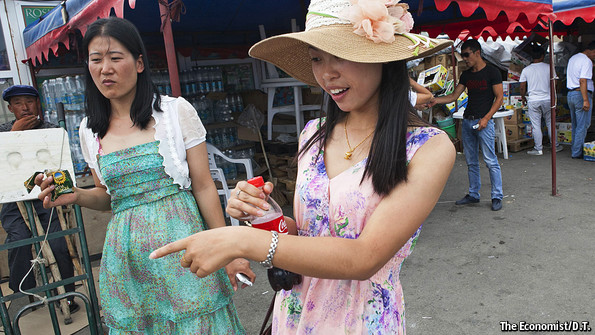THE SUPPLY CHAIN IMPACT!!!!!
The New Silk Road
Hardly an oasis
Kazakhstan turns geography to advantage as China builds a “New Silk Road”

THE faded mural crumbling by the side of the road once reminded drivers that they had reached the edge of the empire: it shows a musclebound Red Army soldier clutching binoculars and leading a dog beneath a watchtower. Only the militarised frontier with China lay ahead. Now the Russians are gone and the Kazakhs, flush with oil money, have plans almost as vast as their country. Hitching their future to the wagon of the new regional superpower, Kazakhstan is building a dry port and rail yard at Khorgos, in the desert on its eastern border with China, that will help to realise China’s multibillion-dollar plans for a “New Silk Road”.
As Chinese manufacturers move inland, getting their products to European markets has become more complicated. The journey back to the coast and halfway around the world by sea takes up to 60 days—an eternity for the latest iPads and other “fast fashion” products. Kazakhstan offers a backdoor route. Trains from Chongqing in south-west China to Duisburg in Germany, 10,800 kilometres (6,700 miles) via Kazakhstan, Russia, Belarus and Poland, supposedly take just 14 days.
Kazakhstan’s state-run railway, KTZ, promises to spend $44 billion over the next five years to make that ten days. In the first year after the Khorgos link opened in late 2012, the volume of 40-foot containers passing from China to Europe across Kazakhstan jumped by 80%, to 6,600; it is on track to reach 10,000 this year. That is still modest. Yet Yerkhat Iskaliyev, the head of Kazlogistics, a state-run transportation outfit, projects annual revenues of $3.5 billion by 2020.
Most containers still travel by sea, which is considerably cheaper—about $4,000 each rather than $9,000. But the gap is narrowing as European manufacturers start filling the empty carriages going back to China with high-priced products such as luxury cars. Ronald Kleijwegt, who runs logistics in Asia for Hewlett-Packard, a big maker of information-technology hardware, says this year is the first when freight volumes going east have shown strong growth. The railway fits neatly into the vision of Xi Jinping, China’s president, who has championed the New Silk Road as an alternative to American-controlled sea-lanes. On November 8th Mr Xi pledged $40 billion to “break the connectivity bottleneck” in Asia.
Success, however, depends also on Russia, China’s rival for influence in Central Asia. It was a Russian-led project that helped streamline transport across Eurasia in the first place. In 2011 Kazakhstan, along with Russia and Belarus, formed a customs union, which is scheduled to become the Eurasian Union in January. Kazakh critics say the union is Vladimir Putin’s attempt to rebuild the Soviet empire. Worryingly, Russia’s erratic behaviour in Ukraine has coincided with a drop by a fifth in customs-union trade this year. Many Kazakhs were alarmed when, in August, Mr Putin humiliated Kazakhstan by saying the country had no history and then mustering troops for exercises near the border.
But the common market has slashed the number of bribe-hungry customs agents between China and Europe (at the Kazakh-Russian and Russian-Belarusian borders). Mr Kleijwegt hails the customs union for dismantling these “bottlenecks” and knocking four to six days off the journey. On the other hand, he cautions that tensions between Russia and the West make the route vulnerable. Europeans are likely to find relying on Russia for their goods makes them uncomfortable.
In October Russia threatened to block Western food products passing through Kazakhstan and Belarus, to enforce countersanctions that it had imposed after the West targeted Russia for its annexation of Crimea and incursions into Ukraine. And how committed is Kazakhstan? The depressing effect the Ukraine crisis is having on the region, and the drop in oil prices, has led Kazakhstan to revise its growth target for 2014 downward by almost one-third and it is reviewing the state budget.
Grand building plans often disproportionately benefit the Kazakhstani elite, because few mechanisms ensure that state funds are doled out transparently. Pervasive tales of corruption at Kazakhstan’s borders “do not mirror the image of a state that wants to be more open and trade more,” says Luca Anceschi, who studies Kazakhstan’s governance at the University of Glasgow. Corruption runs from top to bottom. On October 30th Kazakhstan’s border chief was charged with organised crime and soliciting bribes.
Another multibillion-dollar project at Khorgos—a free-trade zone opened in 2011—could be a forewarning. The Chinese have built guesthouses, banks and shopping malls on their side. For all its promises, Kazakhstan has dumped a few rusty kiosks in the desert, where bemused Chinese tourists buy ice cream, snap the odd photo, and retreat, smirking. A lot of Kazakhstan’s infrastructure projects are done out of vanity,” says Mr Anceschi. “When you look from declarations to substance there is not much to show.” There are many ways a train can derail.

No comments:
Post a Comment